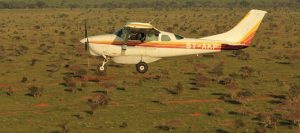
Earlier this month Elephants without Borders conducted an independent assessment of Kenya’s most important elephant population, in Tsavo. The results back up the findings of the KWS census conducted in February, showing that the region is not in crisis, but is nonetheless afflicted by a serious poaching problem.
Counting elephants is surprisingly difficult. All published elephant population figures are estimates, close to the truth, but no-one knows exactly how many elephants there are in Tsavo, or any other major population. The count technique used by KWS was a ‘total count’, and the provisional results estimate a minimum of 11,000 elephants in the area.
Elephants Without Borders, on the other hand, used a ‘sample count’ technique with well-established statistical techniques to extrapolate from an exacting survey of 6% of the area. They estimated that the most probable population was 14,000 elephants, with a small probability that the number could be as low as 11,000 or as high as 17,000.
No fresh elephant carcasses were seen but the team estimated a total of 3,129 elephant carcasses in the Tsavo ecosystem survey area, representing a carcass ratio of 18 per cent. To the north and south of the core area much higher carcass ratios were observed, indicating the higher risk to elephants in these areas of the landscape.
A moderate decline
The only way of establishing trends, and to gauge how Tsavo’s elephants are faring is to compare with earlier surveys of the same type. The total count results showed a moderate decline of an estimated 1,500 elephants between 2011 and 2014.
The Kenya Wildlife Service (KWS) has taken this drop as evidence that poaching is still serious, but that there has not been an elephant holocaust. By comparison across the border in Tanzania, the Selous lost 67% of its elephants in four years.
Controlling errors
In a sample survey, with the result being extrapolated from only a small proportion of the total population, it is critical that the area surveyed is counted as accurately as possible. To this end the project’s survey aircraft was equipped with high-end digital cameras to confirm every observation, and the aircraft was flown within tightly-controlled speed limits with its height continuously monitored with a laser altimeter. All sources of observer fatigue – a serious potential source of error – were carefully mitigated.
“The technical standards of the survey led by Dr Mike Chase of Elephants without Borders in Tsavo were higher than any other I’ve witnessed in more than 40 years of counting elephants,” said Iain Douglas-Hamilton, Founder and CEO of Save the Elephants. “It’s a great start to the Second Pan-African Elephant Census.”
Dr Douglas-Hamilton led the first continent-wide survey thirty years ago, and in 1979 estimated that at least 1.3 million elephants lived across Africa. By the mid 1980s that number had halved. The second, year-long survey is being led by Dr Mike Chase of Elephants without Borders and funded by Microsoft billionaire Paul Allen.
KWS Acting Director General William Kiprono welcomed the findings saying that science will guide conservation agenda in the country going forward.

